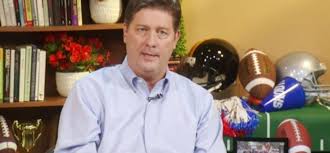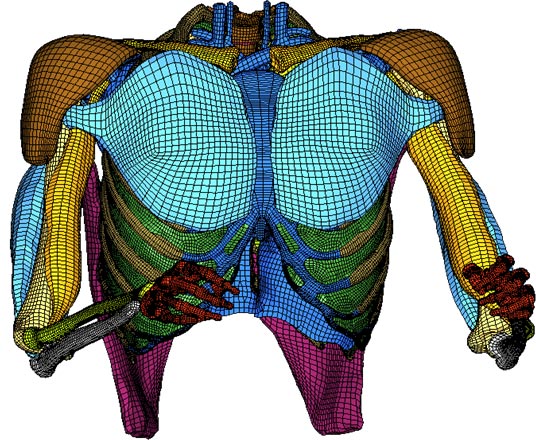You know how the standards for football helmets cause much gnashing of teeth and created rules in the NFL about what helmets you can and cannot wear and consternation about helmets that are not allowed anymore (read: Tom Brady and read: Adam Vinatieri) and passionate debates about what it really means to be the highest rated and how minuscule the actual difference is in the best and worst rated acceptable helmets?
Not to mention safer helmets.
Know that?
Well, get ready. The football world may be facing the same kind of rankings and testings and discussions and such, this time with shoulder pads.
Research May Start Immediately
“We are looking at the topic of shoulder pad standards,” Michael Oliver told us at Helmet Tracker. Oliver is the Executive Director and General Counsel at NOCSAE. NOCSAE is the National Operating Committee on Standards for Athletic Equipment.
“We’ve not formally started the process, but every new standard begins with a broad survey of what is out there, what are the injuries, how frequent those injuries are.”

“We ask if there are standards in place from somewhere and what a set of standards are trying to protect.”
NOCSAE will address the issue at this weekend’s meetings in Boston. Its decision could set off a multi-year process of research, study, testing, discussion, and eventually the creation of standards for football shoulder pads.
NOCSAE Efforts
Here’s how they put it in a press release several months ago:
“NOCSAE is also considering possible criteria for a performance standard for football shoulder pads. While the most common shoulder injuries cannot be prevented by shoulder pads, limited research studies suggest shoulder pads could potentially provide a buffer to other collision dynamics. The Standards Committee voted to continue to explore both areas and consider potential criteria for safety standards.”
Oliver said some of the first steps would be to find any research related to the effectiveness of shoulder pads to prevent or reduce injuries, and to find any data about shoulder injuries in football.
“We, of course, know that football players wear shoulder pads and we think it is mandated by the organizations and leagues that run football and we think there are no standards for shoulder pads,” Oliver said. “But, we need to find out what kinds of injuries happen to the shoulder in the course of football.”
Not Necessarily the Shoulder
The focus on building a better shoulder pad and establishing standards for shoulder pads and developing tests to determine if a shoulder pad meets the standards may address several shoulder injury issues, but that may not be the most important focus.
“Coming from research for the NFL where they have done so many concussive event reconstructions, one of the things they are noticing – somewhere in the 20 percent range – is that some concussive events occur when the helmet comes into contact with the shoulder pad of the other player,” Oliver told us. “So the question has been raised: Would a shoulder pad standard affect those concussive events? We know what we require of helmets when it comes to damping concussive forces, but we don’t have anything about the shoulder pad.”

Later this fall, NOCSAE will meet with Biocore to discuss the topic. The NFL has relied on Biocore research for years to provide research, data, and consultation about equipment and safety.
NFL and the AEMA
The NFL is interested in the topic—specifically the Equipment Managers who work in the league.
These Equipment Managers have formed a group—one that requires certification by AEMA for membership, said Sam Trusner, Office Manager for the AEMA—the Athletic Equipment Managers Association, which administers the Certification Exam.

“These guys want to have one voice with the league and the players’ association,” Sam told us.
“We’ve been working with their safety committee about NOCSAE’s interest in coming up with a standard for shoulder pads,” he said.
These efforts regarding football helmets, Trusner said, have proven beneficial to players.
“I think we are getting a lot better helmets, safer helmets, now because of the standards and the testing,” he said. “I knew NOCSAE was working on the shoulder pads and it’s been interesting to see it right from the beginning.”
Material, Fit, and Design
The research, data, and testing could help determine everything from the padding used on a shoulder pad (we know some players remove as much of the padding as they can), to how it’s positioned and what it’s all made of.
“We need to not only understand the performance of the equipment, but also probably a coverage issue as well,” Oliver said. “How close to the neck should the shoulder pad come? How high should they be, how tight should they be, how should they be harnessed?”
Impact on Shoulder Pad Manufacturers
Yes, a new standard could impact how shoulder pads are made and marketed, but in the end, the whole effort is to look out for football players.
“The primary stakeholder is the athlete who should benefit from using equipment that provides an acceptable level of protection,” Oliver said. “We don’t look at sales or manufacturing, but we have to take them into account if we move toward establishing a standard that organizations will abide with.”
After all, if a league such as the NFL or a ruling body such as the NCAA adopts a standard for a specific piece of equipment, then that equipment must be available to players and teams. It does no good to establish a standard and not give manufacturers time to develop the product.
First, though, standards must be established based on research and testing, then agreed to.
Standards Not Always Adopted
NOCSAE has no authority or leverage to force any athlete to adhere to equipment standards—that’s the league’s job. When NOCSAE says a football helmet must pass certain tests to be certified by the organization, it means nothing until the NFL or the NCAA or another entity says its players must wear helmets that are NOCSAE certified.
“Someone must mandate compliance with the standards or they are just words on a page,” Oliver admits.
“A perfect example,” be beings. “Look, we have standards for lots of equipment – for helmets, soccer shin guards and a whole pile of equipment. We have a standard for ice hockey helmets—a very demanding standard that requires far more than the current standard by the high school association and the NCAA.”
“They aren’t interested in adopting our standards because they don’t want the helmet to change. We have a standard out there that would result in an ice hockey helmet that would protect far more than the one currently used, but I can’t compel anyone to adopt our standards.”
Oliver said it would be a minimum of two years before a new standard for shoulder pads is in place—that is, if the organization decided to go forward tomorrow or Saturday. There is the research, the data, the development of a testing mechanism, the detailed standards, buy-in by significant sports organizations, time for manufacturers to respond, and more.
“The first step will be to hold a six-month comment period,” Oliver told Helmet Tracker. “Anyone who wants to comment—we take all those comments and address them individually by providing a response. The Standards Committee will look at those comments and determine what to do next.”
Other NOCSAE Topics
Additional football helmet testing and standards will go into effect in November. The main change is a new drop test that measures the helmet’s ability to manage the rotational acceleration.
This standard took time to adopt because the testing equipment had to be developed.
Additionally, NOCSAE will address the “the protection of the integrity of the certification, managing the inflow of counterfeit products, tighten certification process, and more,” Oliver said.